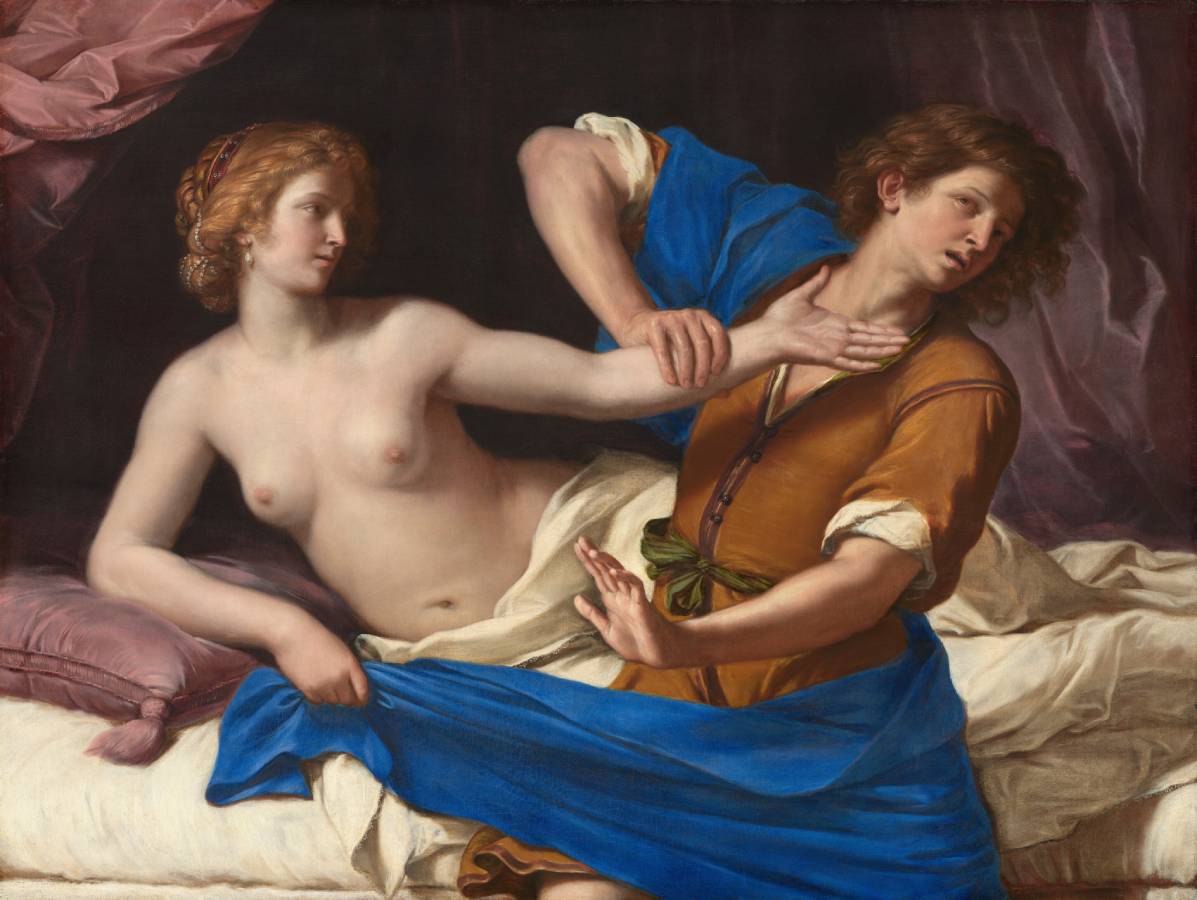Guercino (1591-1666)
Giuseppe e la moglie di Putifar (Joseph and Potiphar’s Wife)
1649
Oil on canvas, 123.2 x 158 cm
National Gallery of Art, Washington
A nude woman with pale pink skin reclines under cream-white sheets in a bed as she reaches for the cloak of a man with light skin standing in front of the bed, who leans away with arms raised in this horizontal painting. The mattress runs along the bottom edge of the canvas, and the man is shown from the knees up. The woman’s bare torso faces us, hips stacked, as she turns her face to our right in profile, looking at the man. She props her body up with her right elbow, to our left, on a mauve-pink pillow. With that hand, she clutches the end of the man’s royal-blue cloak. With her other hand, she reaches with palm up across the body of the man toward his face. Her strawberry-blond hair is pulled back under a muted red ribbon, woven with pearls, and gathered at the nape of her neck. Soft curls frame her forehead and temple. A teardrop pearl earring dangles from her right earlobe. Her nose is long and slender, and her small, pale peach lips are slightly parted. The man’s body is angled toward the woman, to our left, but he twists and leans away, to our right. With elbow raised, he grips her extended forearm with his right hand, to our left. He raises his other arm with his palm out. He looks up with brown eyes under raised brows. His mouth is open and his head tipped sharply away from the woman so his chin-length, wavy, brown hair hangs by his face. He wears an ochre-yellow, thigh-length tunic over a white shirt. A thin olive-colored belt is tied in a bow at his waist. His vivid blue cloak wraps over his right upper arm, farther from us, around his torso and hips, and is pulled by the woman. Rose-pink, shiny curtains frame the scene in the upper corners, and beyond, the background is swallowed in shadow. For this depiction of Joseph spurning the advances of his Egyptian employer’s wife, as recounted in the Book of Genesis, Guercino chose a three-quarter length format that presses the life-sized figures close to the spectator. He has filled the scene with the bed — all rumpled sheets and opulent curtains. As the temptress reaches for the strong and handsome Joseph, he struggles vigorously to extricate himself. But she holds tight to the vivid blue cloak and sets Joseph spinning like a top out of his garment. In panic, he turns his imploring eyes heavenward, seeming to realize that even if he escapes with his virtue unscathed, he is helplessly ensnared in an evil plot; Potiphar’s wife, bejeweled and confident, will later use the cloak to support her denunciation of Joseph as the aggressor. With a delicate play of light on the seductress’ profile, the artist shows the very moment of lust shading into treachery. If Guercino‘s narration is clear and eloquent, his presentation of the moral implications is more subtle: as this woman’s beauty conceals her wickedness, so the visual lushness of Guercino‘s painting disguises a serious lesson about righteous conduct. (NGA)
